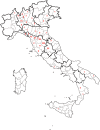Human tularemia in Italy. Is it a re-emerging disease?
- PMID: 25336123
- PMCID: PMC9506981
- DOI: 10.1017/S0950268814002799
Human tularemia in Italy. Is it a re-emerging disease?
Abstract
Tularemia is a contagious infectious disease due to Francisiella tularensis that can cause serious clinical manifestations and significant mortality if untreated. Although the frequency and significance of the disease has diminished over the last decades in Central Europe, over the past few years, there is new evidence suggesting that tularemia has re-emerged worldwide. To know the real epidemiology of the disease is at the root of correct control measures. In order to evaluate whether tularemia is re-emerging in Italy, data on mortality and morbidity (obtained by the National Institute of Statistics; ISTAT), Italian cases described in the scientific literature and data concerning hospitalizations for tularemia (obtained by the National Hospital Discharge Database) were analysed. From 1979 to 2010, ISTAT reported 474 cases and no deaths. The overall number of cases obtained from the literature review was at least 31% higher than that reported by ISTAT. Moreover, the number of cases reported by ISTAT was 3·5 times smaller than hospitalized cases. In Italy tularemia is sporadic, rarely endemic and self-limiting; but, although the trend of reported tularemia does not support the hypothesis of a re-emerging disease, the study demonstrates a wide underreporting of the disease. The real frequency of the disease should be carefully investigated and taken into account in order to implement specific prevention measures.
Keywords: Compulsory reporting; Italy; discharge forms; epidemiology; tularemia.
Figures
References
-
- Foley JE, Nieto NC. Tularemia. Veterinary Microbiology 2010; 140: 332–338. - PubMed
-
- Maurin M, et al. Human tularemia in France, 2006–2010. Clinical Infectious Diseases 2011; 53: 133–141. - PubMed
-
- Keim P, Johansson A, Wagner DM. Molecular epidemiology, evolution and ecology of Francisella. Annals of the New York Academy of Sciences 2007; 1105: 30–66. - PubMed
-
- World Health Organization. WHO Guidelines on Tularemia. Geneva: WHO Press, 2007. (http://www.cdc.gov/tularemia/resources/whotularemiamanual.pdf).
-
- Greco D, Ninu E. A family outbreak of tularemia. European Journal of Epidemiology 1983; 3: 232–233. - PubMed
Publication types
MeSH terms
LinkOut - more resources
Full Text Sources
Other Literature Sources
Miscellaneous



